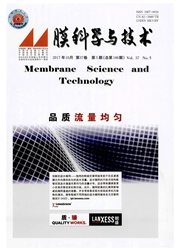

 中文摘要:
中文摘要:
以季铵化BPPO中空纤维膜为原料,通过sol-gel反应填充巯丙基三乙氧基硅烷(KH580),然后进行氧化,得到同时含有季铵和磺酸基团的杂化荷电镶嵌膜,阴离子交换容量(AEC)和阳离子交换容量(CEC)分别为1.57~1.76 mmol/g和1.07~1.24 mmol/g.对该膜进行了结构和物化性能的表征,然后进行蛋白质吸附和脱附.结果表明,与基膜相比,荷电镶嵌膜在溶胀度方面有所改进.pH=4、7和8时荷电镶嵌膜对牛血清蛋白(BSA)的吸附量较高,可达到20mg/g以上.在碱性条件下(pH=8),脱附率明显高于基膜,可以达到约95%.由此说明基于BPPO的荷电镶嵌中空纤维膜可以用作吸附材料.
 英文摘要:
英文摘要:
Quaternized BPPO hollow fiber membrane was used as the starting material and modified by sol- gel and oxidization reactions of 3-mercaptopropyltriethoxysilane (KH580), so that ion exchange mosaic hybrid membranes containing -N+ (C2 H5 ) 3 and --SO3 H groups were obtained. The anion and cation exchange capacities (AEC and CEC) were 1.57-1.76 mmol/g and 1.07-1.24 mmol/g respectively. The structure and physico-chemical properties of the membranes were characterized and then the membranes were applied for protein adsorption and desorption performances. The results showed that the swelling resistance of the ion exchange mosaic membranes was improved as compared with the base membrane. The adsorption capacities for bovine serum albumin (BSA) at pH= 4, 7 and 8 were relatively higher and could reach more than 20 mg/g. The desorption capacity under alkaline conditions (pH = 8) was obviously higher than the BPPO base membranes and could reach around 95%. The results indicate that the BPPO- based ion exchange mosaic membranes can be potentially used as adsorption materials.
 同期刊论文项目
同期刊论文项目
 同项目期刊论文
同项目期刊论文
 The effects of multi-functional groups from PVA and ternary multisilicon copolymer on diffusion dial
The effects of multi-functional groups from PVA and ternary multisilicon copolymer on diffusion dial Optimized Process for Separating NaOH from Sodium Aluminate Solution: Coupling of Electrodialysis an
Optimized Process for Separating NaOH from Sodium Aluminate Solution: Coupling of Electrodialysis an Separation of alumina alkaline solution by electrodialysis: Membrane stack configuration optimizatio
Separation of alumina alkaline solution by electrodialysis: Membrane stack configuration optimizatio Cation exchange hybrid membranes from SPPO and multi-alkoxy silicon copolymer: Preparation, properti
Cation exchange hybrid membranes from SPPO and multi-alkoxy silicon copolymer: Preparation, properti PVA-based cation exchange hybrid membranes with multifunctional groups prepared from ternary multisi
PVA-based cation exchange hybrid membranes with multifunctional groups prepared from ternary multisi Cation exchange hybrid membranes prepared from PVA and multisilicon copolymer for application in alk
Cation exchange hybrid membranes prepared from PVA and multisilicon copolymer for application in alk Anion exchange membranes used in diffusion dialysis for acid recovery from erosive and organic solut
Anion exchange membranes used in diffusion dialysis for acid recovery from erosive and organic solut Porous BPPO-based membranes modified by multisilicon copolymer for application in diffusion dialysis
Porous BPPO-based membranes modified by multisilicon copolymer for application in diffusion dialysis 期刊信息
期刊信息
